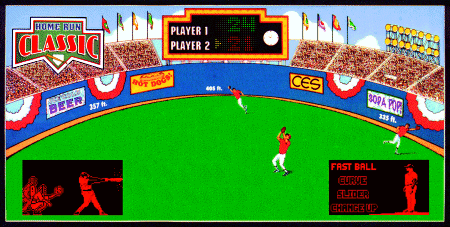

Home Run Classic (Creative Electronics and Software, Inc., 1996)
The Home Run Classic wall game features dot matrix graphics on two bright, red-orange gas plasma animation panels, combined with the more traditional lamp-motion animation. An interesting feature is that the score display is an LED matrix panel as opposed to the typical lamp-illuminated segment display used by other manufacturers. The LED matrix display is a tri-color display, wherein each LED could be green, yellow, or red. In addition to the animation on the Vishay Dale gas-plasma graphic displays, the LED matrix scoreboard also displays animation (in three colors) as the ball is hit.
This game incorporated several features you always wanted in your Gremlin game, including gas-charged lifts to hold the game front open for servicing, microprocessor control, upgradeable software programming stored in EPROMs, easily replaceable 555 lamps, adjustable game pricing with both coin and dollar bill acceptors, and built-in diagnostics features. The coin box cable is armored. The game power supply is a regular computer AT power supply, with the typical power connectors.
The game includes a full range of sound effects, including an announcer, fan noise, exchanges between fans and vendors ("Peanuts!", "Beer here!"), and music. The animation is exceptional.
Like Gremlin's baseball games, scoring is 4 points for a home run, 3 points for a triple, 2 points for a double, 1 point for a single, and no points for a foul ball or a strike. However, unlike Gremlin, a strike does not result in your opponent being awarded a point.
Whereas Gremlin baseball games were played to a selected score level, Home Run Classic delivers an operator-selected number of pitches to each player. Upon achieving a specified score, a relief pitcher ("Lefty") is brought in to replace the starter. The relief pitcher offers a different set of pitches, which are generally more difficult to hit. Bonus pitches are awarded for reaching a relatively high score level, and a free game can be won at an even higher level.
A single RF remote control is shared between two players. It is interesting to note that the remote control has a larger than usual push-button, which is not electrical, but mechanical. The remote control button acts as an extension to the push button on an actual garage door remote control mounted to the inside of the larger remote control box. Stanley remote controls, and later Liftmaster, were used for this purpose.
A dollar bill acceptor was an optional component to this game.
Replacing your lost or broken CES remote controls